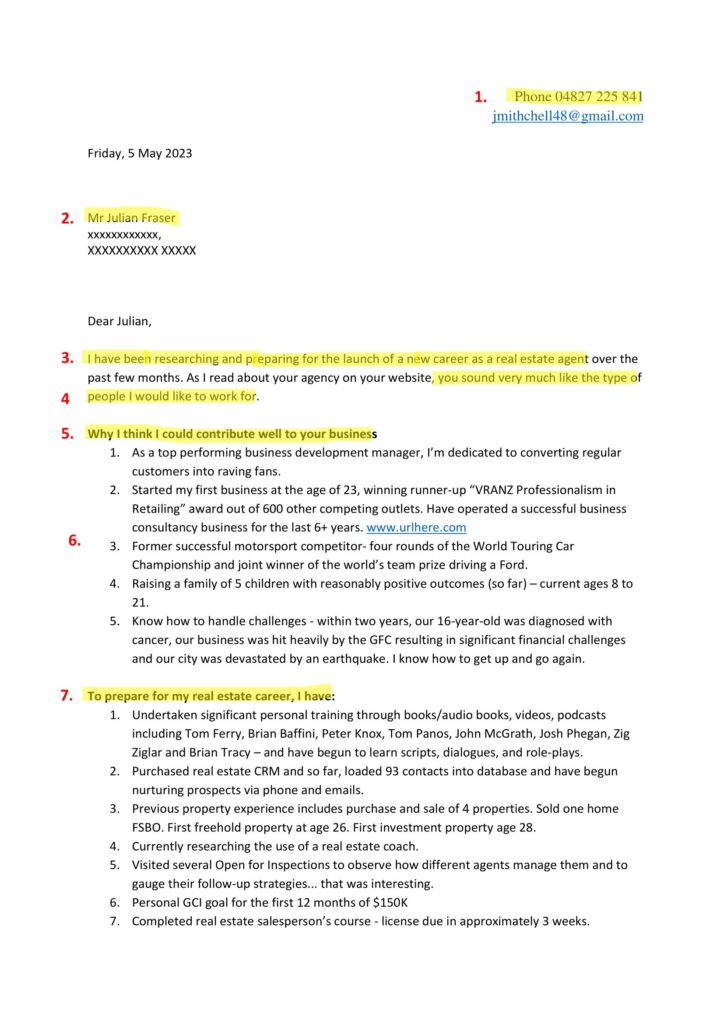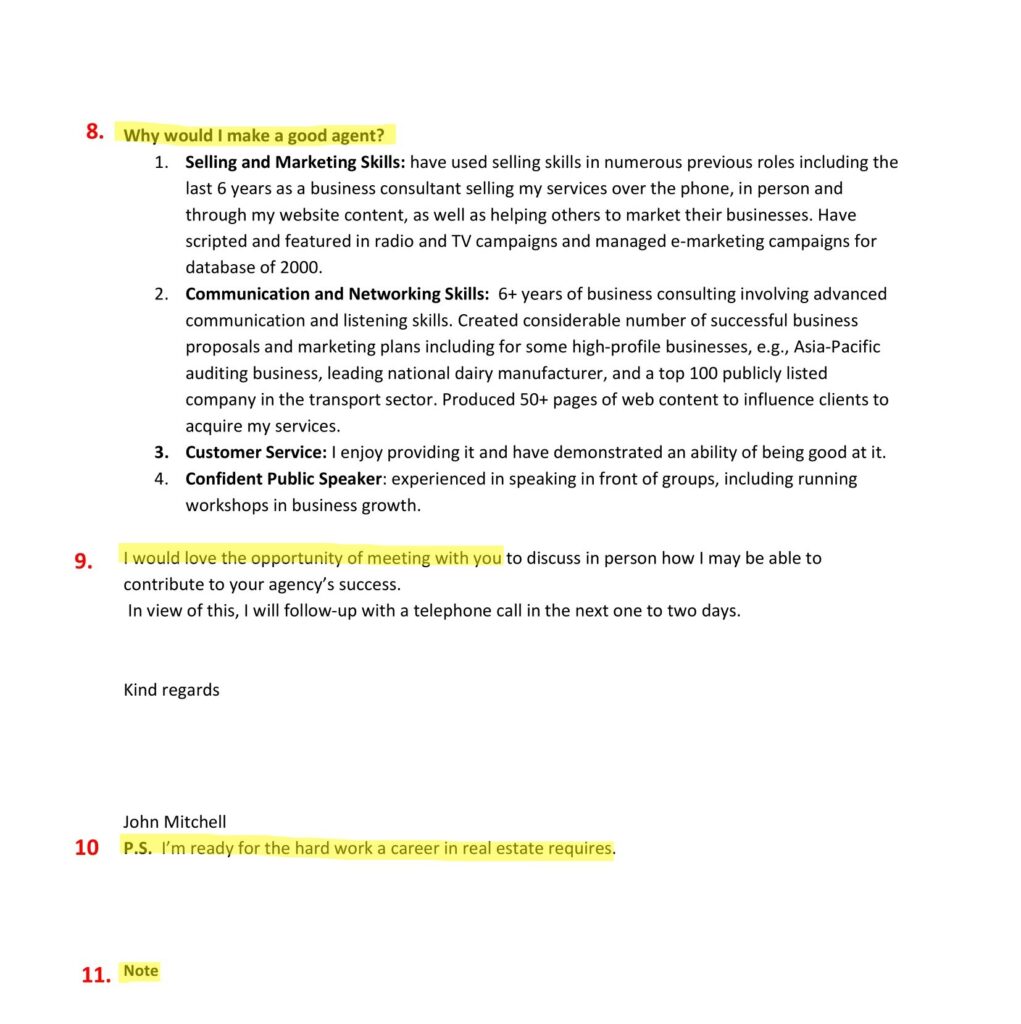
Here is one successful example where a job applicant achieved great success without ever applying for a job online.
It simply involved a well-crafted letter that I wrote (see sample below). No resume was sent. An unconventional delivery method and phone call follow-up were implemented.
None of the companies he sent it to were advertising at the time, but this letter received a 60% success rate!
That is, for every 10 letters that were sent out and followed up with a phone call, the applicant managed to secure six interviews resulting in two offers (I think 12-15 letters were sent in total).
That’s an extremely high success rate.
It was primarily due to high energy, well-crafted letter, unconventional delivery method, disciplined phone call follow-up, and in this case, some good experience.
Some may say that this involves a lot of work, but compared to the many weeks and months the average person spends applying for jobs online and becoming depressed at the lack of response, this method is comparatively more successful, faster, and in most cases, easier.
No Competition
Another reason it is so successful is that unlike applying for jobs online, you have no competition!
When you send a letter like this out, there is no one else applying for the job because there was no job advertised.
Many people think that because a company is not currently advertising, they don’t need staff.
This is not true.
Most organizations are always looking for good staff. I have had employers say to me “We’re not really looking for anyone at the moment, however, we are always interested in speaking to the right person if they come along”.
In other words, they are nearly always hiring.
Obviously, there are some exceptions to this where an industry is going through a major downturn or in the case where a particular business is struggling through poor management or other causes.
It’s a bit ironic that in the same way, employees find it difficult to secure a good job, employers find it difficult to find good workers!
When you proactively job search in this manner, it becomes a win-win for everyone.
Free Letter to Employer (Download)
Here is the letter and below are accompanying comments and tips about what to change for each section before you send it (as per the red numbers)
You can download:
- A full Word Doc of the successful letter (save a copy in case you need the original again)
- A PDF of the letter with comments and tips for various sections of the letter


careers-advice-online.com/wp-content/uploads/2023/05/Job-Seeking-Prospecting-Letter.pdf
Numbered Notes for the Above Letter
1. This letter received a 60% hit rate. That is, for every 10 letters (I think 12-15 letters were sent in total) the applicant managed to secure 6 meetings/ interviews and subsequently two offers.
1A. Include your phone number and e-mail only at the top. No need to include the home address.
2. Address the letter to the person with the authority to make hiring decisions inside the organization. You should be able to obtain the name from their website, Facebook page, or LinkedIn profile, or if all else fails, call up the business and say something like “Hi I have some resources (you are the resource) that I would like to forward to the owner/ manager of the business. Who should I address it to please?”
3. I recommend you use an opening sentence very similar to this. Get straight to the point about why you are writing to them. Business owners are busy people and it’s important to communicate concisely and clearly. The way you communicate will, in itself, tell them a lot about you as a potential employee.
4. Make it clear that you really want to work for them. Enthusiasm and energy for the job – and the company – are key reasons an employee is appealing to a business.
5. This heading is very clear about what the following list contains. It’s a good idea to use lists and bullet points in your letter. This makes it faster and easier for the reader. Also using bullet points avoids the tendency to ramble – keep it succinct and sharp.
6. This is where you list your top three or four reasons why you would be good for their business (which is really all they are interested in). Provide facts here, including numbers, time frames, awards, percentages, etc. Note that this letter has included sporting and family achievements. You can go outside your work experience to provide evidence of the skills, abilities and character traits you have if there is a transferable connection between them and the job you are seeking. This person knew that successful real estate agents work extremely hard and so the traits in this list illustrate their conscientiousness in all areas of life.
7. This is a critical part of your letter. This person did not have any experience in the real estate industry. All of the learning items in this list were initiated by the applicant through self-learning over a period of a few months prior to sending out this letter. This will greatly impress most employers as they see someone who is extremely conscientious, highly motivated, and proactive. The character traits you display while carrying out your job search are paid a lot of attention to by an employer and they will rightly assume these traits would continue to be displayed as an employee.
8. This last section connects the skills and experience you have with the job you are seeking. In some ways, it is a continuation of the first section but here you are summarizing and also adding some more specificity and evidence as to why you would make a good agent. You don’t need to list everything here like you would in a resume. The whole point of this letter is to generate enough interest in the employer to want to meet with you. And the decision to meet with you will also be influenced by the follow-up phone call you make (see last paragraph).
9. The closing paragraph is about one thing – and that is to announce that you will follow up this letter with a phone call in the coming days. When you make the follow-up call, ask directly to speak with the person you addressed the letter to. Open the conversation by saying something like “Hi Mr. Fraser it’s John Mitchell speaking, I’m following up on the letter I sent last week regarding my entry into the real estate industry. Did you receive my letter?”
From there, his answer will determine your next step, but basically, the purpose of the call is simply to secure a meeting. A possible follow-up line could be “Mr. Fraser, I’m going to be passing by your office on Wednesday, would it be OK if I popped in and briefly introduced myself?”
10. Did you know that a ‘P.S.’ at the bottom of a letter is one of the most read parts of a letter? For example, if a person decides not to read the whole letter, they nearly always read the PS at the bottom. It is one part of the letter that is very impactful and it is the last thing that a person will usually read. Say something powerful.
11. You could send this letter via e-mail but I wouldn’t recommend it. I suggest you print it out on high-quality paper and send it in a courier pack (not post) directly to the person with the authority to make hiring decisions. Emails can get lost, not opened, and are generally a lot less impactful. And postal envelopes are often opened by someone other than the person you want to reach. Courier packs are generally put straight on the desk of the person to whom they are addressed to. But this method of delivery is also impactful simply because it is different. One of the key aspects of marketing yourself well is doing things that other people don’t do, thereby making yourself stand out.
Here is the download for the Word document example and here is the download for the PDF which is the same letter but includes comments and tips relating to different sections of the letter. You will need both.